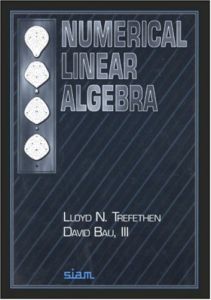This is a concise, insightful introduction to the field of numerical linear algebra. The clarity and eloquence of the presentation make it popular with teachers and students alike. The text aims to expand the reader's view of the field and to present standard material in a novel way. All of the most important topics in the field are covered with a fresh perspective, including iterative methods for systems of equations and eigenvalue problems and the underlying principles of conditioning and stability. Presentation is in the form of 40 lectures, which each focus on one or two central ideas. The unity between topics is emphasized throughout, with no risk of getting lost in details and technicalities. The book breaks with tradition by beginning with the QR factorization - an important and fresh idea for students, and the thread that connects most of the algorithms of numerical linear algebra. Contents: Preface; Acknowledgments; Part I: Fundamentals. Lecture 1: Matrix-Vector Multiplication; Lecture 2: Orthogonal Vectors and Matrices; Lecture 3: Norms; Lecture 4: The Singular Value Decomposition; Lecture 5: More on the SVD; Part II: QR Factorization and Least Squares. Lecture 6: Projectors; Lecture 7: QR Factorization; Lecture 8: Gram-Schmidt Orthogonalization; Lecture 9: MATLAB; Lecture 10: Householder Triangularization; Lecture 11: Least Squares Problems; Part III: Conditioning and Stability. Lecture 12: Conditioning and Condition Numbers; Lecture 13: Floating Point Arithmetic; Lecture 14: Stability; Lecture 15: More on Stability; Lecture 16: Stability of Householder Triangularization; Lecture 17: Stability of Back Substitution; Lecture 18: Conditioning of Least Squares Problems; Lecture 19: Stability of Least Squares Algorithms; Part IV: Systems of Equations. Lecture 20: Gaussian Elimination; Lecture 21: Pivoting; Lecture 22: Stability of Gaussian Elimination; Lecture 23: Cholesky Factorization; Part V: Eigenvalues. Lecture 24: Eigenvalue Problems; Lecture 25: Overview of Eigenvalue Algorithms; Lecture 26: Reduction to Hessenberg or Tridiagonal Form; Lecture 27: Rayleigh Quotient, Inverse Iteration; Lecture 28: QR Algorithm without Shifts; Lecture 29: QR Algorithm with Shifts; Lecture 30: Other Eigenvalue Algorithms; Lecture 31: Computing the SVD; Part VI: Iterative Methods. Lecture 32: Overview of Iterative Methods; Lecture 33: The Arnoldi Iteration; Lecture 34: How Arnoldi Locates Eigenvalues; Lecture 35: GMRES; Lecture 36: The Lanczos Iteration; Lecture 37: From Lanczos to Gauss Quadrature; Lecture 38: Conjugate Gradients; Lecture 39: Biorthogonalization Methods; Lecture 40: Preconditioning; Appendix: The Definition of Numerical Analysis; Notes; Bibliography; Index. Audience: Written on the graduate or advanced undergraduate level, this book can be used widely for teaching. Professors looking for an elegant presentation of the topic will find it an excellent teaching tool for a one-semester graduate or advanced undergraduate course. A major contribution to the applied mathematics literature, most researchers in the field will consider it a necessary addition to their personal collections.
In Collection
#931
Read It:
Yes
#931
Read It:
Yes
|
|
||||||||||||||||||
